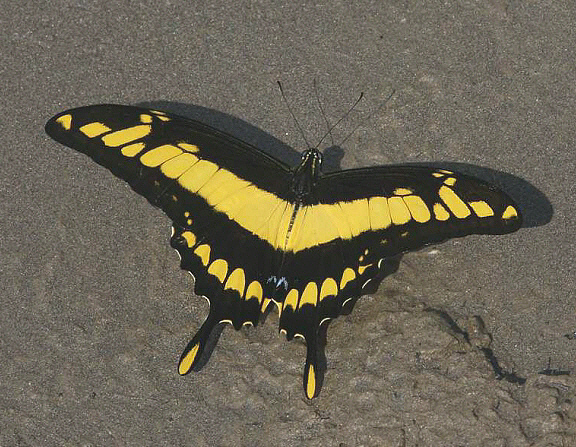
Papilio thoas, or Heraclides thoas (Papilio thoas, or Heraclides thoas)
Phylum — arthropoda
Class — insecta
Order — lepidoptera
Family — papilionidae
Genus – papilio
Appearance
The wingspan is 100–130 mm. The main background of the wings is dark brown-black. There are bright yellow broad stripes running along it, and there is a number of yellow rounded spots on the lower wings. The hindwings have long, narrow extensions.
Habitat
It is found in the southernmost United States, Mexico, Central America and South America (as far south as Argentina and Uruguay).
Behavior
Papilio thoas demonstrates daily activity. Males are often seen on river beaches, dry riverbeds, wet sunny paths, and other places where they can absorb mineralized moisture. Sometimes they can be seen singly, but more often they are found in a small group containing about 4-6 insects.
Diet
The caterpillars feed on the leaves of citrus plants (Rutaceae). Adult Papilio thoas fly year round in the tropics, feeding on nectar of a variety of flowers, including Lantana, Stachytarpheta, and Bougainvillea among other species.
While feeding, the front wings of the butterflies continuously flutter.
Reproduction
Eggs laid by butterflies are chestnut-colored, spherical and smooth. Eggs are laid one at a time on the leaves or stems of forage plants. The color of the caterpillars resembles bird droppings. The caterpillars have an osmetrium, a special gland located behind the head. The gland is pushed out of the caterpillar's body in case of possible danger.
The approximate lifespan of an adult is 5-7 days.
In captivity
To make the butterfly active, it is necessary to maintain the temperature in the room at the level of 23-30 oC. The butterfly can live at lower temperatures, even at +15 oC, but it will be sleepy and inactive. If the temperature rises, the butterfly will be active again.
It is necessary to spray the butterfly several times a day with clean water at room temperature from the flower sprayer. And if you have a steam humidifier, then it's great! With the help of it you can maintain high humidity in the room. If you do not have a sprayer or a humidifier, you can simply moisten your hands with water and spray on the butterfly.
Butterflies are very fond of light and being indoors, they will always strive for its source. In this regard, the following rules should be observed:
1) Close the windows in the room where the butterfly lives.
2) Slide the tulle so that the butterfly does not beat against the glass (this will save the wings).
3) If the room has a chandelier with lampshades in the form of a bowl turned up, do not turn it on. A butterfly can die by flying in there.
At home the butterfly must be fed once a day. You can also do it 2-3 times if you see that the butterfly has stuck out its proboscis and is looking for something. That means it's hungry. You can feed it with water with natural honey /homemade jam: dilute one spoonful of honey/jam in a glass of water and slightly pour the resulting mixture into a saucer or into another shallow container with low edges, and best of all on a wooden surface, such as a cutting kitchen board, so that the butterfly can safely cling to its legs and not slip.
To feed a butterfly, you need to bring a saucer with a mixture or a piece of fruit to the butterfly. There are special taste buds on the front legs of the butterfly so when you feel the sweet smell, the butterfly itself will stick out its proboscis and start eating.
At night, the butterfly can be placed in a box with a piece of wet cloth or sponge inside, or left to sleep on a wall or curtain.
 Russian
Russian
 English
English























